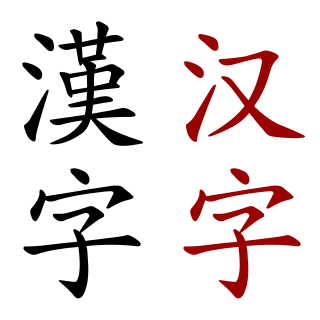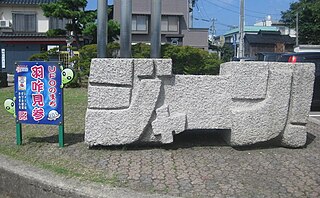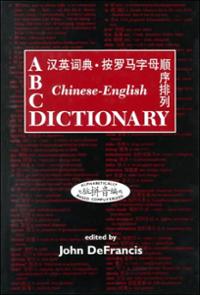
Chinese is a group of languages spoken natively by the ethnic Han Chinese majority and many minority ethnic groups in China. Approximately 1.3 billion people, or around 16% of the global population, speak a variety of Chinese as their first language.

Onomatopoeia is the use or creation of a word that phonetically imitates, resembles, or suggests the sound that it describes. Common onomatopoeias include animal noises such as oink, meow, roar, and chirp. Onomatopoeia can differ by language: it conforms to some extent to the broader linguistic system. Hence, the sound of a clock may be expressed variously across languages: thus as tick tock in English, tic tac in Spanish and Italian, dī dā in Mandarin, kachi kachi in Japanese, or tik-tik in Hindi and Bengali.

Kanji are the logographic Chinese characters adapted from the Chinese script used in the writing of Japanese. They were made a major part of the Japanese writing system during the time of Old Japanese and are still used, along with the subsequently-derived syllabic scripts of hiragana and katakana. The characters have Japanese pronunciations; most have two, with one based on the Chinese sound. A few characters were invented in Japan by constructing character components derived from other Chinese characters. After the Meiji Restoration, Japan made its own efforts to simplify the characters, now known as shinjitai, by a process similar to China's simplification efforts, with the intention to increase literacy among the common folk. Since the 1920s, the Japanese government has published character lists periodically to help direct the education of its citizenry through the myriad Chinese characters that exist. There are nearly 3,000 kanji used in Japanese names and in common communication.

Chinese characters are logographs used to write the Chinese languages and others from regions historically influenced by Chinese culture. Chinese characters have a documented history spanning over three millennia, representing one of the four independent inventions of writing accepted by scholars; of these, they comprise the only writing system continuously used since its invention. Over time, the function, style, and means of writing characters have evolved greatly. Informed by a long tradition of lexicography, modern states using Chinese characters have standardised their forms and pronunciations: broadly, simplified characters are used to write Chinese in mainland China, Singapore, and Malaysia, while traditional characters are used in Taiwan, Hong Kong, and Macau.

The four-corner method or four-corner system is a character-input method used for encoding Chinese characters into either a computer or a manual typewriter, using four or five numerical digits per character.

The Kangxi Dictionary is a Chinese dictionary published in 1716 during the High Qing, considered from the time of its publishing until the early 20th century to be the most authoritative reference for written Chinese characters. Wanting an improvement upon earlier dictionaries, as well as to show his concern for Confucian culture and to foster standardization of the Chinese writing system, its compilation was ordered by the Kangxi Emperor in 1710, from whom the compendium gets its name. The dictionary was the largest of its kind, containing 47,043 character entries. Around 40% of them were graphical variants, while others were dead, archaic, or found only once in the Classical Chinese corpus. In today's vernacular written Chinese, fewer than a quarter of the dictionary's characters are commonly used.

The Japanese language has a large inventory of sound symbolic or mimetic words, known in linguistics as ideophones. Such words are found in written as well as spoken Japanese. Known popularly as onomatopoeia, these words do not just imitate sounds but also cover a much wider range of meanings; indeed, many sound-symbolic words in Japanese are for things that make no noise originally, most clearly demonstrated by 'silently', not to be confused with the religion Shintō.

Written Cantonese is the most complete written form of a Chinese language after that for Mandarin Chinese and Classical Chinese. Written Chinese was originally developed for Classical Chinese, and was the main literary language of China until the 19th century. Written vernacular Chinese first appeared in the 17th century, and a written form of Mandarin became standard throughout China in the early 20th century. Cantonese is a common language in places like Hong Kong and Macau. While the Mandarin form can to some extent be read and spoken word for word in other Chinese varieties, its intelligibility to non-Mandarin speakers is poor to incomprehensible because of differences in idioms, grammar and usage. Modern Cantonese speakers have therefore developed new characters for words that do not exist and have retained others that have been lost in standard Chinese.
The 214 Kangxi radicals, also known as Zihui radicals, were collated in the 18th-century Kangxi Dictionary to aid categorization of Chinese characters. They are primarily sorted by stroke count. They are the most popular system of radicals for dictionaries that order characters by radical and stroke count. They are encoded in Unicode alongside other CJK characters, under the block "Kangxi radicals", while graphical variants are included with in the "CJK Radicals Supplement".
Sentence-final particles, including modal particles, interactional particles, etc., are minimal lexemes (words) that occur at the end of a sentence and that do not carry referential meaning, but may relate to linguistic modality, register or other pragmatic effects. Sentence-final particles are common in Chinese, including particles such as Mandarin le 了, ne 呢, ba 吧, ou 哦, a 啊, la 啦, ya 呀, and ma 嗎/吗, and Cantonese lo 囉 and ge 嘅. These particles act as qualifiers of the clause or sentence they end. Sentence-final particles are also present in Japanese and many East Asian languages, such as Thai, and especially in languages that have undergone heavy Sino-Tibetan influence, such as the Monguor languages.

Taiwanese Mandarin, frequently referred to as Guoyu or colloquially as Huayu, is the variety of Mandarin Chinese spoken in Taiwan. A large majority of the Taiwanese population is fluent in Mandarin, though many also speak a variety of Min Chinese known as Taiwanese Hokkien, commonly called Minnanyu, Southern Min, or Hokkien. This language has had a significant influence on Mandarin as spoken on the island.

The Xinhua Zidian, or Xinhua Dictionary, is a Chinese language dictionary published by the Commercial Press. It is the best-selling Chinese dictionary and the world's most popular reference work. In 2016, Guinness World Records officially confirmed that the dictionary, published by The Commercial Press, is the "Most popular dictionary" and the "Best-selling book ". It is considered a symbol of Chinese culture.

A Chinese dictionary is a reference work for the Chinese language. There are two main types of Chinese dictionaries: zidian, which list individual Chinese characters and their definitions, and cidian, which list words and short phrases along with their meanings. Because written Chinese consists of tens of thousands of characters, over time editors of Chinese dictionaries have developed a number of ways to organize them for convenient reference.

The 1615 Zìhuì is a Chinese dictionary edited by the Ming Dynasty scholar Mei Yingzuo. It is renowned for introducing two lexicographical innovations that continue to be used in the present day: the 214-radical system for indexing Chinese characters, which replaced the classic Shuowen Jiezi dictionary's 540-radical system, and the radical-and-stroke sorting method.
Grammatical particles, or simply particles, are words that convey certain grammatical meanings. The term is often applied to words that are difficult to classify according to traditional grammar. Both Classical Chinese and Modern Standard Chinese make use of particles. In Chinese, particles are known as zhùcí or yǔzhùcí. They belong to function words. In other words, they have no lexical meaning, but are used to indicate certain grammatical information. This contrasts with content words. Particles in Chinese usually take the neutral tone.: p. 238
Hokkien, a Southern Min variety of Chinese spoken in Southeastern China, Taiwan and Southeast Asia, does not have a unitary standardized writing system, in comparison with the well-developed written forms of Cantonese and Vernacular Chinese (Mandarin). In Taiwan, a standard for Written Hokkien has been developed by the Republic of China Ministry of Education including its Dictionary of Frequently-Used Taiwan Minnan, but there are a wide variety of different methods of writing in Vernacular Hokkien. Nevertheless, vernacular works written in Hokkien are still commonly seen in literature, film, performing arts and music.
Zhonghua Zihai is the largest Chinese character dictionary available for print, compiled in 1994 and consisting of 85,568 different characters.

The Concise Dictionary of Spoken Chinese (1947), which was compiled by Yuen Ren Chao and Lien Sheng Yang, made numerous important lexicographic innovations. It was the first Chinese dictionary specifically for spoken Chinese words rather than for written Chinese characters, and one of the first to mark characters for being "free" or "bound" morphemes according to whether or not they can stand alone as a complete and independent utterance.

The ABC Chinese–English Dictionary or ABC Dictionary (1996), compiled under the chief editorship of John DeFrancis, is the first Chinese dictionary to collate entries in single-sort alphabetical order of pinyin romanization, and a landmark in the history of Chinese lexicography. It was also the first publication in the University of Hawaiʻi Press's "ABC" series of Chinese dictionaries. They republished the ABC Chinese–English Dictionary in a pocket edition (1999) and desktop reference edition (2000), as well as the expanded ABC Chinese–English Comprehensive Dictionary (2003), and dual ABC English–Chinese, Chinese–English Dictionary (2010). Furthermore, the ABC Dictionary databases have been developed into computer applications such as Wenlin Software for learning Chinese (1997).
Chinese character order, or Chinese character indexing, Chinese character collation and Chinese character sorting, is the way in which a Chinese character set is sorted into a sequence for the convenience of information retrieval. It may also refer to the sequence so produced. English dictionaries and indexes are normally arranged in alphabetical order for quick lookup. But Chinese is written in tens of thousands of different characters, not just dozens of letters in an alphabet, and that makes the sorting job much more challenging.













